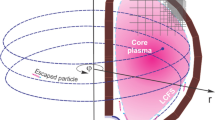Abstract
In this paper we proposed a advanced Langmuir probe (LP)—cooling monoblock (CM) model used in Tokamak of controlled thermonuclear fusion, this model adopted several novel designs used for improving the heat transfer capability. In the transient thermal analysis, the effect of conical degree of AL2O3 ceramic barrel on the thermal contact resistance at the interface of different materials has been systematically studied and a reasonable explanation was given for the phenomenon where the increasing of conical degree lead to the decreasing of thermal contact resistance. Moreover the top part of CM of the plasma facing unit was prepared by pyrolytic graphite can make the temperature of LP obviously reduced. Eventually the thermal state of LP during the 400 s pulse are figured out by ANSYS under optimal loading conditions, the calculation results showed the maximum temperature of LP is 2,253°C at 211 s, meanwhile, the basic characteristics for variation of the maximum temperature of LP with the incident heat flux are presented. These results obtained in this work are helpful to reveal the thermal energy state of LP more accurately, reduce the damage on the device, and improve its working stability.












Similar content being viewed by others
References
W. Amatucci et al., Contamination-free sounding rocket Langmuir probe. Rev. Sci. Instrum. 72(4), 2052 (2001)
M. Stanojević, M. Čerček, T. Gyergyek, Experimental study of planar Langmuir probe characteristics in electron current-carrying magnetized plasma. Contrib. Plasma Phys. 39(3), 197–222 (1999)
M. Ghorannevis et al., Design and fabrication of Langmuir probe circuit for measurement of plasma edge electron temperature and density in IR-T1 Tokamak. J. Sci. IAU (JSIAU). 17(63), 42–47 (2007)
C. Fanara, I.M. Richardson, A Langmuir multi-probe system for the characterization of atmospheric pressure arc plasmas. J. Phys. D Appl. Phys. 34, 2715–2725 (2001)
Maass, Trends in conduction cooling for avionics. Comput. Packag. Technol. 9, 56–59 (1993)
V. Komarov, A. Labusov, Lifetime of irradiated iter divertor heat sink. Plasma Devices Oper. 11(1), 29–37 (2003)
V. Komarov et al., Design progress of the ITER divertor cassette-to-vacuum vessel locking system. Fusion Eng. Design 82, 1866–1870 (2007)
W. Gu, A calculation of the thermal contact resistance at random surface. J. Aerosp. Power 10(3), 233–236 (1995)
S.H. Kunkel, W.M. Peck, Predicting thermal contact resistance in circuit card assemblies. in Proceedings of InterSociety Conference Thermal Phenomena, Arlington, TX, 1994, pp. 91–100
L. Lin et al., Optimal design of electrostatic probe via finite element method and experimental investigation. J. Fusion Energ. (2011) doi:10.1007/s10894-011-9484-2
T. Wang et al., Thermal analysis of a new type langmuir probe based on numerical simulation and experimental studies. J. Fusion Energ. 31(1), 79–83 (2011)
ANSYS FLOTRAN CFD Analysis Guide, ANSYS Release 10.0, ANSYS, Inc., 2006
ANSYS Contact Technology Guide Section 6.1.4.1
Acknowledgments
This work is supported by National Special Fund for the Territorial Resources in the Public Interest (No. 201111020-2), Natural Science Foundation of Fujian Province of China (Grant No. 2011J01320) and Foundation of Overseas Chinese Affairs Office of the State Council for Huaqiao University (No. 11QZR15).
Author information
Authors and Affiliations
Corresponding author
Rights and permissions
About this article
Cite this article
Lin, H., Qiu, H. & Wang, T. Energy Field Simulating of Heat Transfer Capability and Damage Evaluation on an Improved Langmuir Probe. J Fusion Energ 31, 573–579 (2012). https://doi.org/10.1007/s10894-012-9507-7
Published:
Issue Date:
DOI: https://doi.org/10.1007/s10894-012-9507-7




